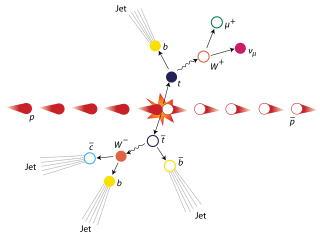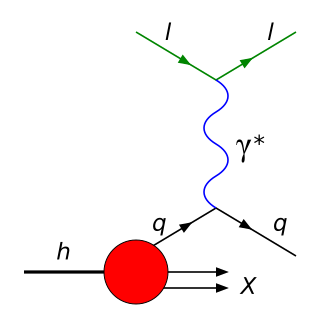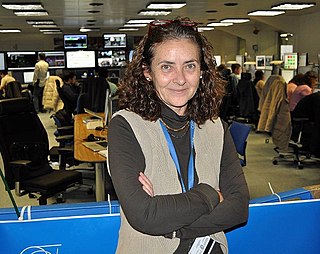Related Research Articles

A quark is a type of elementary particle and a fundamental constituent of matter. Quarks combine to form composite particles called hadrons, the most stable of which are protons and neutrons, the components of atomic nuclei. All commonly observable matter is composed of up quarks, down quarks and electrons. Owing to a phenomenon known as color confinement, quarks are never found in isolation; they can be found only within hadrons, which include baryons and mesons, or in quark–gluon plasmas. For this reason, much of what is known about quarks has been drawn from observations of hadrons.

The top quark, sometimes also referred to as the truth quark, is the most massive of all observed elementary particles. It derives its mass from its coupling to the Higgs Boson. This coupling is very close to unity; in the Standard Model of particle physics, it is the largest (strongest) coupling at the scale of the weak interactions and above. The top quark was discovered in 1995 by the CDF and DØ experiments at Fermilab.
In particle physics, the W and Z bosons are vector bosons that are together known as the weak bosons or more generally as the intermediate vector bosons. These elementary particles mediate the weak interaction; the respective symbols are
W+
,
W−
, and
Z0
. The
W±
bosons have either a positive or negative electric charge of 1 elementary charge and are each other's antiparticles. The
Z0
boson is electrically neutral and is its own antiparticle. The three particles each have a spin of 1. The
W±
bosons have a magnetic moment, but the
Z0
has none. All three of these particles are very short-lived, with a half-life of about 3×10−25 s. Their experimental discovery was pivotal in establishing what is now called the Standard Model of particle physics.
The Panofsky Prize in Experimental Particle Physics is an annual prize of the American Physical Society. It is given to recognize and encourage outstanding achievements in experimental particle physics, and is open to scientists of any nation. It was established in 1985 by friends of Wolfgang K. H. Panofsky and by the Division of Particles and Fields of the American Physical Society. Panofsky was a physics professor at Stanford University and the first director of the Stanford Linear Accelerator Center (SLAC). Several of the prize winners have subsequently won the Nobel Prize in Physics. As of 2021, the prize included a $10,000 award.

Henry Way Kendall was an American particle physicist who won the Nobel Prize in Physics in 1990 jointly with Jerome Isaac Friedman and Richard E. Taylor "for their pioneering investigations concerning deep inelastic scattering of electrons on protons and bound neutrons, which have been of essential importance for the development of the quark model in particle physics."

Deep inelastic scattering is the name given to a process used to probe the insides of hadrons, using electrons, muons and neutrinos. It was first attempted in the 1960s and 1970s and provided the first convincing evidence of the reality of quarks, which up until that point had been considered by many to be a purely mathematical phenomenon. It is an extension of Rutherford scattering to much higher energies of the scattering particle and thus to much finer resolution of the components of the nuclei.

The Collider Detector at Fermilab (CDF) experimental collaboration studies high energy particle collisions from the Tevatron, the world's former highest-energy particle accelerator. The goal is to discover the identity and properties of the particles that make up the universe and to understand the forces and interactions between those particles.

The DØ experiment was a worldwide collaboration of scientists conducting research on the fundamental nature of matter. DØ was one of two major experiments located at the Tevatron Collider at Fermilab in Batavia, Illinois. The Tevatron was the world's highest-energy accelerator from 1983 until 2009, when its energy was surpassed by the Large Hadron Collider. The DØ experiment stopped taking data in 2011, when the Tevatron shut down, but data analysis is still ongoing. The DØ detector is preserved in Fermilab's DØ Assembly Building as part of a historical exhibit for public tours.
The timeline of particle physics lists the sequence of particle physics theories and discoveries in chronological order. The most modern developments follow the scientific development of the discipline of particle physics.

James Daniel "BJ" Bjorken is an American theoretical physicist. He was a Putnam Fellow in 1954, received a BS in physics from MIT in 1956, and obtained his PhD from Stanford University in 1959. He was a visiting scholar at the Institute for Advanced Study in the fall of 1962. Bjorken is Emeritus Professor in the SLAC Theory Group at the Stanford Linear Accelerator Center, and was a member of the Theory Department of the Fermi National Accelerator Laboratory (1979–1989).

Richard Edward Taylor,, was a Canadian physicist and Stanford University professor. He shared the 1990 Nobel Prize in Physics with Jerome Friedman and Henry Kendall "for their pioneering investigations concerning deep inelastic scattering of electrons on protons and bound neutrons, which have been of essential importance for the development of the quark model in particle physics."

Guido Tonelli is an Italian particle physicist who was involved with the discovery of the Higgs boson at the Large Hadron Collider. He is a professor of General Physics at the University of Pisa (Italy) and a CERN visiting scientist.

Sir Tejinder Singh Virdee,, is a Kenyan-born British experimental particle physicist and Professor of Physics at Imperial College London. He is best known for originating the concept of the Compact Muon Solenoid (CMS) with a few other colleagues and has been referred to as one of the 'founding fathers' of the project. CMS is a world-wide collaboration which started in 1991 and now has over 3500 participants from 45 countries.
Paul Dutton Grannis is an American physicist.

]
Paraskevas Andreas Sphicas is a particle physicist who focuses on studies of High energy collisions in the Large Hadron Collider through which he explores supersymmetry and the mechanism of spontaneous symmetry breaking. He is a senior scientist at CERN and professor of physics at the National and Kapodistrian University of Athens. He was elected a Fellow of the Royal Society (FRS) in 2019.
Frank J. Sciulli is an American experimental physicist, specializing in particle physics.

Teresa Rodrigo Anoro was a Spanish scientist who worked in particle physics. She worked at CERN, Fermilab and the Instituto de Física de Cantabria and was professor at the University of Cantabria. Whilst at CERN, Rodrigo worked on the Compact Muon Solenoid and research for the Higgs boson.

Bradley Cox is an American physicist, academic and researcher. He is a Professor of Physics and the founder of the High Energy Physics Group at the University of Virginia.

Sheldon Leslie Stone was a distinguished professor of physics at Syracuse University. He is best known for his work in experimental elementary particle physics, the Large Hadron Collider beauty experiment (LHCb), and B decays. He made significant contributions in the areas of data analysis, LHCb detector design and construction, and phenomenology.
References
- ↑ Faculty biography, University of Rochester Archived February 8, 2008, at the Wayback Machine
- ↑ "Prize Recipient".
- ↑ "The Nobel Prize in Physics 1990". www.nobelprize.org. Retrieved 2016-07-21.
- ↑ "Jerome I. Friedman, Henry W. Kendall, Richard E. Taylor and the Development of the Quark".
- ↑ "EPJ". www.epj.org. Retrieved 2016-07-21.
- ↑ "The European Physical Journal C".
- ↑ "Arie Bodek Named George e. Pake Professor of Physics".
- ↑ Patterson, Scott (2012). Dark Pools: High-Speed Traders, A.I. Bandits, and the Threat to the Global Financial System. Crown Publishing. p. 24. ISBN 978-0307887177.
- ↑ "State of Innovation".[ permanent dead link ]
- ↑ "Stanford Spire".[ permanent dead link ]